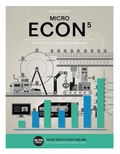
Whether Amos McCoy is currently earning an economic profit or not.
Concept Introduction:
Amos McCoy is not currently making an economic profit. Difference between the revenue received from the sale of an output and the
Explanation of Solution
Both alternatives are considered (i.e explicit and implicit cost) while estimating economic cost. Accounting cost does not take into consideration implicit cost. Opportunity cost associated with raising soyabean is being ignored while calculating accounting profit. While raising corn at a profit of $100 per acer, profit of $200 per acer is being ignored on soyabean. Economic loss of $100 is being incurred ($200-$100=$100). Amos McCoy is not currently making an economic profit. In the end, it should be concluded that he should grow soyabeans and get out of the corn business.
Want to see more full solutions like this?
- Stark Industries' accounting profit for the year ended 31 December 2012 amounted to $3,130 million. CEO Tony Stark could have earned an amount of $230 million by signing up for different movies instead of running the stark industries. Instead of developing the Iron Man outfit, the resources could have been used to develop robots for medical use. The project could have earned a profit of $1,500 million. Find Stark Industries' economic profit.arrow_forward1. What is the formula to calculate profits? 2. Define Explicit and Implicit Costs. 3. Define Economic Profit and Accounting Profit. 4. Define Production Function, Marginal Product, and Diminishing Marginal Product. 5. Define Fixed Costs and Variable Costs. 5. Provide the formula/calculation for the following costs: Average Total Cost, Average Fixed Cost, Average Variable Cost, Marginal Cost. 6. Define Minimum Average Cost and Efficient Scale. 7. Define Economies of Scale, Diseconomies of Scale, Constant returns to scale.arrow_forwardQuestion When do firms decide to shut down production in the short run? Explain it. How is the short run average cost curve and the long run average cost curve shaped? What is the difference between them? Graphical representation of the short-run total cost curve showing total cost, fixed cost, variable cost: and The marginal cost and average total cost:arrow_forward
- Part – A: A Leading manufacturer of Action Figures is about to introduce four new Action Figures. The accompanying table summarizes price and cost data, combined fixed costs equal $75,000. A marketing research study predicts that for each unit sold of Noyan, 2 units of Dogan, 5 units of Bamsi and 4 units of Turgut will be sold. Action Figures Turgut Bamsi Dogan Noyan Selling Price (in dollars) 32 27 25 15 Variable Cost/unit (in dollars) 16 13 11 11 Table 1 How many product mix units must be sold to break even? How does it translate into sales of individual games?arrow_forwardq3- The average total cost curve is increasing when marginal cost is: Select one: a. decreasing b. increasing c. less than average total cost d. greater than average total costarrow_forward7. Define Economies of Scale, Diseconomies of Scale, Constant returns to scale.arrow_forward
- Question 17: The sequence of processes required to produce and distribute a product is know as A Supply chain B Conglomeration C Integration D Process Managementarrow_forward1.Joe quits his computer programming job, where he was earning a salary of $50,000 per year, to start his own computer software business in a building that he owns and was previously renting out for $24,000 per year. In his first year of business he has the following expenses: salary paid to himself, $40,000; rent, $0; other expenses, $25,000. Find the accounting cost and the economic cost associated with Joe’s computer software business.arrow_forward3-1 Fixed-Cost Fallacy Describe a decision made by your company that involved costs that should have been ignored. Why did your company make the decision? What should it have done? Compute the profit consequences of the change.arrow_forward
- 6. Define Minimum Average Cost and Efficient Scale.arrow_forward12 true or false The point at which the marginal product of a variable input is at a maximum corresponds to the point at which marginal cost is at a maximumarrow_forwardKevin quits his computer programming job, where he was earning a salary of $60,000 per year, to start his own computer software business in a building that he owns and was previously renting out for $24,000 per year. In his first year of business, he has the following expenses: salary paid to himself, $40,000; rent, $0; other actual expenses, $25,000. Calculate the accounting cost and the economic cost associated with Kevin’s computer software business. If Kevin’s total revenue for the first year was $70,000 how much revenue would his business need to generate to earn positive economic profit? Explain briefly.arrow_forward

 Managerial Economics: A Problem Solving ApproachEconomicsISBN:9781337106665Author:Luke M. Froeb, Brian T. McCann, Michael R. Ward, Mike ShorPublisher:Cengage Learning
Managerial Economics: A Problem Solving ApproachEconomicsISBN:9781337106665Author:Luke M. Froeb, Brian T. McCann, Michael R. Ward, Mike ShorPublisher:Cengage Learning

